Articles
- Page Path
- HOME > J Korean Acad Nurs > Volume 43(1); 2013 > Article
-
Original Article
- Analysis of Burnout and Job Satisfaction among Nurses Based on the Job Demand-Resource Model
- Young-Hee Yom
-
Journal of Korean Academy of Nursing 2013;43(1):114-122.
DOI: https://doi.org/10.4040/jkan.2013.43.1.114
Published online: February 28, 2013
Red Cross College of Nursing, Chung-Ang University, Seoul, Korea.
- Address reprint requests to: Yom, Young-Hee. Red Cross College of Nursing, Chung-Ang University, 224-1 Heukseok-dong, Dongjak-gu, Seoul 156-755, Korea. Tel: +82-2-820-5700, Fax: +82-2-824-7691, yhyom@cau.ac.kr
• Received: July 19, 2012 • Accepted: November 8, 2012
© 2013 Korean Society of Nursing Science
Abstract
-
Purpose
- The purpose of this study was to examine burnout and job satisfaction among nurses based on Job Demand-Resource Model.
-
Methods
- A survey using a structured questionnaire was conducted with 464 hospital nurses. Analysis of data was done with both SPSS Win 17.0 for descriptive statistics and AMOS 18.0 for the structural equation model.
-
Results
- The hypothetical model yielded the following Chi-square=34.13 (p = <.001), df=6, GFI=.98, AGFI=.92, CFI=.94, RMSR=.02, NFI=.93, IFI=.94 and showed good fit indices. Workload had a direct effect on emotional exhaustion (β = 0.39), whereas supervisor support had direct effects on emotional exhaustion (β = -0.24), depersonalization (β = -0.11), and low personal accomplishment (β = -0.22). Emotional exhaustion (β = -0.42), depersonalization (β = -0.11) and low personal accomplishment (β = -0.36) had significant direct effects on job satisfaction.
-
Conclusion
- The results suggest that nurses' workload should be decreased and supervisor's support should be increased in order to retain nurses. Further study with a longitudinal design is necessary.
- 1. Ahn SA, Yea CJ, Yeum DM. The impact of nurses' job demands, job resources, emotional labor and emotional intelligence on burnout. Soc Sci Res Rev. 2011;27(4):25–43.
- 2. Aiken LH, Clarke SP, Sloane DM, Sochalski J, Silber JH. Hospital nurse staffing and patient mortality, nurse burnout, and job dissatisfaction. JAMA. 2002;288(16):1987–1993. http://dx.doi.org/10.1001/jama.288.16.1987.Article
- 3. Bakker AB, Demerouti E, Verbeke W. Using the job demands-resources model to predict burnout and performance. Hum Resour Manage. 2004;43(1):83–104.Article
- 4. Brayfield AH, Rothe HF. An index of job satisfaction. J Appl Psychol. 1951;35(5):307–311. http://dx.doi.org/10.1037/h0055617.Article
- 5. Choi HY. Perfectionism tendency, social support, and burnout among counselors. 2002;Bucheon, The Catholic University of Korea. Unpublished master's thesis.
- 6. Demerouti E, Bakker AB, Nachreiner F, Schaufeli WB. The job demands-resources model of burnout. J Appl Psychol. 2001;86(3):499–512. http://dx.doi.org/10.1037/0021-9010.86.3.499.ArticlePubMed
- 7. Garrett C. The effect of nurse staffing patterns on medical errors and nurse burnout. AORN J. 2008;87(6):1191–1204. http://dx.doi.org/10.1016/j.aorn.2008.01.022.ArticlePubMed
- 8. Hong KP. An analytic study on burnout in relation with personal and job related characteristics and social support. 1985;Seoul, Yonsei University. Unpublished doctoral dissertation.
- 9. House JS. Work stress and sicoal support. 1981;Reading, MA, Addison-Wesley.
- 10. Jennings BM. Hughes RG. Work stress and burnout among nurses: Role of the work environment and working conditions. In: Patient safety and quality: An evidence-based handbook for nurses. 2008;Rockville, MD, Agency for Healthcare Research and Quality. 137–158.
- 11. Jourdain G, Chênevert D. Job demands-resources, burnout and intention to leave the nursing profession: A questionnaire survey. Int J Nurs Stud. 2010;47(6):709–722. http://dx.doi.org/10.1016/j.ijnurstu.2009.11.007.ArticlePubMed
- 12. June KJ, Byun SW. Nurse's burnout research throughout the past 10 years in Korea. J Korean Acad Nurs Adm. 2009;15(3):305–313.
- 13. Karasek RA. Job demands, job decision latitude, and mental strain: Implications for job redesign. Adm Sci Q. 1979;24(2):285–308. http://dx.doi.org/10.2307/2392498.Article
- 14. Kim GS. AMOS 4: Analysis structural equation modeling. 2001;Seoul, SPSS Academy.
- 15. Ko JW. The effects of personality traits on job satisfaction. Korean J Sociol. 1999;33(SM):359–387.
- 16. Ko JW, Seo YJ, Park HY. The effect of job stress and social support on the organizational effectiveness of hospital employees. Korean J Prev Med. 1996;29(2):295–309.
- 17. Laschinger HK, Grau AL, Finegan J, Wilk P. New graduate nurses' experiences of bullying and burnout in hospital settings. J Adv Nurs. 2010;66(12):2732–2742. http://dx.doi.org/10.1111/j.1365-2648.2010.05420.x.ArticlePubMed
- 18. Lee KH. A study on the effects of burnout on job attitudes in police officers. 2008;Seoul, Dongguk University. Unpublished doctoral dissertation.
- 19. Lee RT, Ashforth BE. A meta-analytic examination of the correlates of the three dimensions of job burnout. J Appl Psychol. 1996;81(2):123–133. http://dx.doi.org/10.1037/0021-9010.81.2.123.ArticlePubMed
- 20. Leiter MP. Schaufeli WB, Maslach C, Marek T. Burnout as a developmental process: Consideration of models. In: Professional burnout: Recent developments in theory and research. 1993;Washington DC, Taylor & Francis. 237–250.
- 21. Maslach C. Paine WS. Understanding burnout: Definitional issues in analyzing a complex phenomenon. In: Job stress and burnout: Research, theory, and intervention perspectives. 1982;Vol. 29-40. Beverly Hills, Sage.
- 22. Maslach C, Jackson SE. The measurement of experienced burnout. J Organ Behav. 1981;2(2):99–113. http://dx.doi.org/10.1002/job.4030020205.Article
- 23. Maslach C, Schaufeli WB, Leiter MP. Job burnout. Annu Rev Psychol. 2001;52:397–422. http://dx.doi.org/10.1146/annurev.psych.52.1.397.ArticlePubMed
- 24. Melchior ME, Bours GJ, Schmitz P, Wittich Y. Burnout in psychiatric nursing: A meta-analysis of related variables. J Psychiatr Ment Health Nurs. 1997;4(3):193–201. http://dx.doi.org/10.1046/j.1365-2850.1997.00057.x.ArticlePubMed
- 25. Park DS, Cheol HC, Jeong SH. The moderating role of emotional intelligence in the job demands-resources model of burnout. J Organ Manage. 2007;31(1):69–94.
- 26. Park SE, Han SJ. An empirical study on the burnout of nurses based on the job demand-control model. Korean J Hosp Manage. 2006;11(2):32–60.
- 27. Pines AM. Treating career burnout: A psychodynamic existential perspective. J Clin Psychol. 2000;56(5):633–642. http://dx.doi.org/10.1002/(SICI)1097-4679(200005)56:5<633::AID-JCLP5>3.0.CO;2-#.ArticlePubMedPDF
- 28. Rizzo JR, House RJ, Lirtzman SI. Role conflict and ambiguity in complex organizations. Adm Sci Q. 1970;15(2):150–160. http://dx.doi.org/10.2307/2391486.Article
- 29. Vahey DC, Aiken LH, Sloane DM, Clarke SP, Vargas D. Nurse burnout and patient satisfaction. Med Care. 2004;42:2 Suppl. II57–II66. http://dx.doi.org/10.1097/01.mlr.0000109126.50398.5a.
REFERENCES
Figure & Data
REFERENCES
Citations
Citations to this article as recorded by 

- Nursing staff and supervisors perceptions on stress and resilience: a qualitative study
Madeleine Helaß, Anja Greinacher, Melanie Genrich, Andreas Müller, Peter Angerer, Harald Gündel, Florian Junne, Christoph Nikendei, Imad Maatouk
BMC Nursing.2025;[Epub] CrossRef - Toxic university: the relationships between instructor job satisfaction, burnout, conflict resolution styles, and intentions to quit
Kristen Foltz, Stephen M. Kromka, Theresa MacNeil
Communication Quarterly.2025; 73(3): 312. CrossRef - Hospital Nurses’ Professional Quality of Life Model: A Cross‐Sectional Study Based on the Expanded Job Demands‐Resources Model
Younghee Kim, Mi Yu, Jacopo Fiorini
Journal of Nursing Management.2025;[Epub] CrossRef - Effects of Clinical Nurses’ Job Crafting on Organizational Effectiveness Based on Job Demands-Resource Model
Eun Young Lee, Eungyung Kim
Journal of Korean Academy of Nursing.2023; 53(1): 129. CrossRef - The Effect of Burnout and Moral Sensitivity Levels of Surgical Unit Nurses on Job Satisfaction
Nurşen Kulakaç, Sevda Uzun
Journal of PeriAnesthesia Nursing.2023; 38(5): 768. CrossRef - Teachers’ teleworking job satisfaction during the COVID-19 pandemic in Europe
Faisal Mahmood, Antonio Ariza-Montes, Maria Saleem, Heesup Han
Current Psychology.2023; 42(10): 8540. CrossRef - A Structural Model for Burnout and Work Engagement of Nurses in Long-term Care Hospitals: Application of the Expanded Job Demand-Job Resources Model
Eun Ok Yang, Mee Ock Gu
Journal of Korean Gerontological Nursing.2022; 24(1): 108. CrossRef - Effects of occupational hazards and occupational stress on job burn-out of factory workers and miners in Urumqi: a propensity score-matched cross-sectional study
Yaoqin Lu, Qi Liu, Huan Yan, Tao Liu
BMJ Open.2022; 12(9): e051911. CrossRef - Enhancing Employee Creativity in the Banking Sector: A Transformational Leadership Framework
Qinghua Fu, Jacob Cherian, Khalil-ur Rehman, Sarminah Samad, Mohammed Arshad Khan, Mohammad Athar Ali, Laura Mariana Cismas, Andra Miculescu
Sustainability.2022; 14(8): 4643. CrossRef - The effects of job demands and resources on turnover intention: The mediating roles of emotional exhaustion and depersonalization
Soo Kyung Park, Min-Kyoung Rhee, Seon Woo Lee
Work.2021; 70(1): 301. CrossRef - The Influence of Social Support on the Relationship between Emotional Demands and Health of Hospital Nurses: A Cross-Sectional Study
Hyoung Eun Chang, Sung-Hyun Cho
Healthcare.2021; 9(2): 115. CrossRef - The Impact of Occupational Stress on Job Burnout Among Bank Employees in Pakistan, With Psychological Capital as a Mediator
Arslan Khalid, Fang Pan, Ping Li, Wei Wang, Abdul Sattar Ghaffari
Frontiers in Public Health.2020;[Epub] CrossRef - Psychosocial Well-Being of Clinical Nurses Performing Emotional Labor: A Path Analytic Model Approach
Yoonjeong Lee, Hyunli Kim
Journal of Korean Academy of Nursing.2019; 49(3): 307. CrossRef - The Influences of Burnout on Job Satisfaction on School Health Teachers (School Nurse): Focused on the Mediating Effects of Self-leadership
Oh Yun Kwon, Kyung Sook Park
Journal of the Korean Society of School Health.2017; 30(1): 1. CrossRef - Effects of Work Intensity and Physical Discomfort on Job Satisfaction in Clinical Nurses
Hyojin Kim, Soonjoo Park
Journal of Korean Academy of Nursing Administration.2016; 22(4): 362. CrossRef - Mindful Facebooking: The moderating role of mindfulness on the relationship between social media use intensity at work and burnout
Peerayuth Charoensukmongkol
Journal of Health Psychology.2016; 21(9): 1966. CrossRef - The Mediating Role of Psychological Capital on the Association between Occupational Stress and Job Burnout among Bank Employees in China
Xirui Li, Dan Kan, Li Liu, Meng Shi, Yang Wang, Xiaoshi Yang, Jiana Wang, Lie Wang, Hui Wu
International Journal of Environmental Research and Public Health.2015; 12(3): 2984. CrossRef - Influential Factors Related to Job Satisfaction in Hospice Nurses: Focus on Emotional Labor and Burnout
BokYae Chung, Ji-Young Han
Journal of Korean Academy of Nursing Administration.2014; 20(3): 322. CrossRef - An Analysis of Factors Influencing Job Satisfaction among Nurses Working in College Health Centers
Kyu Jung Cha, Mi Ryeong Song
Journal of Korean Academy of Fundamentals of Nursing.2013; 20(3): 259. CrossRef
Analysis of Burnout and Job Satisfaction among Nurses Based on the Job Demand-Resource Model
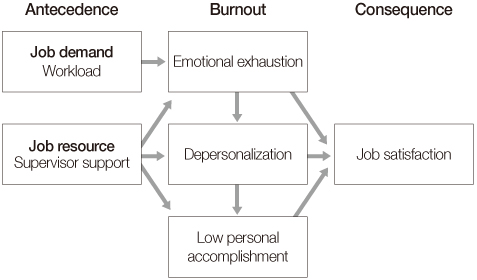
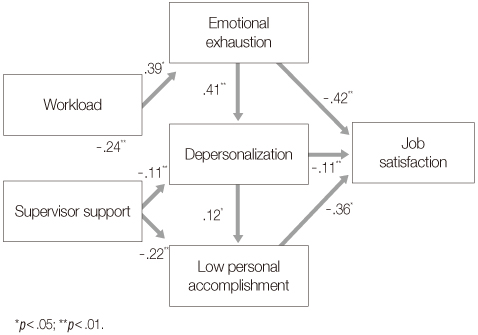
Figure 1
Conceptual framework.
Figure 2
Path diagram of the hypothetical model.
Figure 1
Figure 2
Analysis of Burnout and Job Satisfaction among Nurses Based on the Job Demand-Resource Model
Means and Correlations among Variables
Goodness Fit Indices for the Hypothetical Model
GFI=Goodness of fit index; AGFI=Adjusted goodness of fit index; CFI=Comparative fit index; RMSR=Root mean squared residual; NFI=Normed fit index; IFI=Incremental fit index.
Standardized Direct Effect, Indirect Effect, and Total Effect in the Hypothetical Model
SMC=Squared multiple correlation.
Table 1
Means and Correlations among Variables
Table 2
Goodness Fit Indices for the Hypothetical Model
GFI=Goodness of fit index; AGFI=Adjusted goodness of fit index; CFI=Comparative fit index; RMSR=Root mean squared residual; NFI=Normed fit index; IFI=Incremental fit index.
Table 3
Standardized Direct Effect, Indirect Effect, and Total Effect in the Hypothetical Model
SMC=Squared multiple correlation.
 KSNS
KSNS
 E-SUBMISSION
E-SUBMISSION


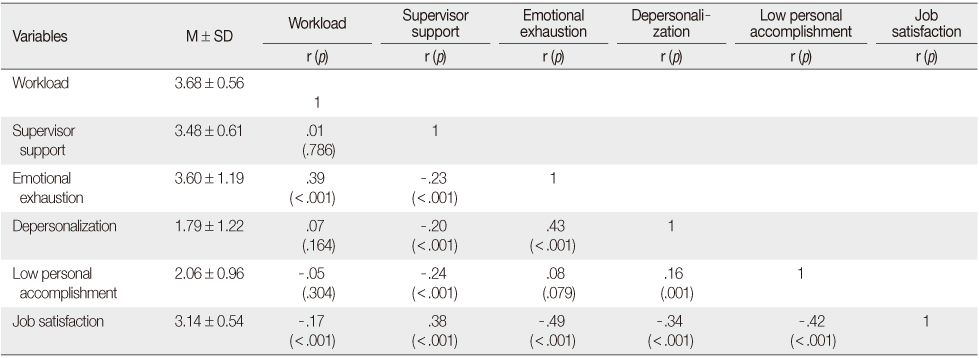
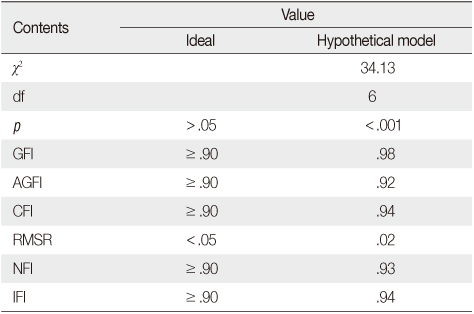
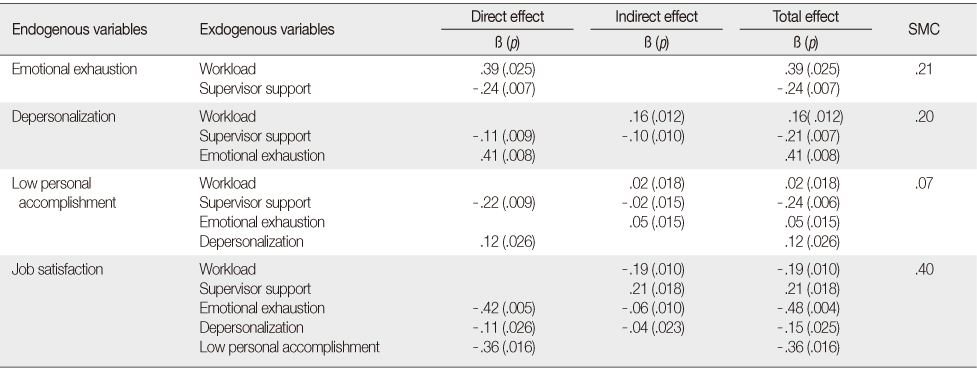
 Cite
Cite

